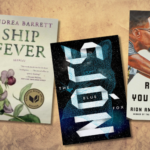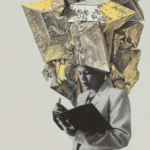
American Intolerance and Book Bans: Book Censorship News, February 2, 2024
This is the fifth in a series of posts that will offer insights and calls to action based on the results of three recent surveys conducted by Book Riot and the EveryLibrary Institute. The surveys explored parental perceptions of public libraries, parental perceptions of librarians, and parental perceptions of school libraries. The first post in the series emphasized how data overwhelmingly supports libraries and library workers. The second looked at how what’s happening in school libraries is foreshadowing the future of public libraries. The third, on why library workers need to be their own advocates of the library, and the fourth, on the erosion of trust in professional library workers despite parental trust in those same professionals.
The freedoms and liberties enshrined in the U.S. Constitution are built on a legacy of cruel and dehumanizing colonialism, slavery, and discrimination from the beginning. This context is important because it weaves through our history, defining whose rights are worth defending — and whose are purposefully excluded.
In America, we do not love thy neighbor.
Intolerance permeates parental perceptions of book bans. This is evident not just among those who believe banning books is an acceptable way to protect children. It is also pervasive among people who purport to trust, respect, and desire the services provided by public and school libraries, foundational democratic institutions whose purpose is to serve the whole of a community.
2 out of 5 parents — 43% — do not agree that books should reflect diverse experiences. When you combine outright disagreement with parents who only somewhat agree with that sentiment, 75% of parents do not believe in the necessity of diverse books. That is an astounding — and incredibly chilling — percentage. 3 out of 4 parents only want to see and be validated in their own beliefs; they do not believe books should showcase the fullness of their communities nor the world at large. For the pleas to protect the children, it is clear protection is only for a certain type of child.
25% of today’s generation of teenagers identify under the LGBTQ+ umbrella. These are teens who openly state that. The real numbers are certainly higher due to fear or stigma around such identification. Meanwhile, 18% of parents believe no one under 18 should ever have access to age-appropriate books that include a queer character or theme. A further 37% of parents are uncomfortable with their school library having any age-appropriate books featuring an LGBTQ+ character or theme, with an additional 28% reporting being only “somewhat” comfortable with these books being on shelves in school libraries. This intolerance is not only of books about queer people. It’s about queer people, period — including the young people these parents ostensibly want to protect.
There is a gross disconnect between the lives of today’s youth and what parents believe to be permissible.
It does not stop at queerphobia, though. 20% of parents are uncomfortable with children’s books about race or racism being available in the school library, while 32% are only “somewhat” comfortable. An additional 9% of parents do not think any children under 18 should have any access to books about race/racism. Racism is an American legacy and enduring characteristic. White people panic about and legislate the “border crisis” — including the building of a literal wall — and at the same time, claim books like Stamped or The Hate U Give make white kids feel bad about themselves and should be banned. We dehumanize and delegitimize our neighbors in service of protecting straight white children from their feelings.
Meanwhile, today’s young people are the most diverse in American history. Only 52% of teenagers are white and non-Hispanic, compared to 61% of Millennials when they were teenagers; 70% of Generation X when they were teenagers; and 82% of Boomers when they were teenagers. One-quarter of today’s teens are Hispanic, while 14% are Black, 6% are Asian, and 5% have two or more racial identities (per PEW). Roughly 6% of today’s teens are immigrants, and 22% are the children of immigrants. Their books reflect this and need to reflect this. If we are only protecting 52% of teenagers — minus, let’s say, 25% of those who will likely be a member of the LGBTQ+ community — then it’s not “the children” being protected.
Library workers — ranked among the most trustworthy professions in these surveys — know this and have worked hard to better reflect their communities in the materials available on shelves. It is far from perfect, and there is plenty of room for improvement. But that last part is key. Most librarians are working to improve the books available to all people in their communities through both collection development (i.e., purchasing books) and through offering digital resources to supplement what their physical space and material budget can accommodate. School and public libraries are publicly funded institutions that uphold the First and Fourteenth Amendment rights of all, not just those with the most perceived power and means. But as much as parents trust library workers and recognize them as purveyors of lifelong learning, those same parents are deeply intolerant of the reality of what inclusivity means. Books by and about Black, Brown, and queer people butt against their actual beliefs about who deserves to be protected.
Parents do not want to say they only care about straight, cisgender, white Christians with their words. But they do so under the auspices of protecting the children by removing access to books that do not align with this identity.
Librarianship as a profession should hold itself accountable here, too. The field struggles with recruiting and retaining a diverse workforce. Little has changed in demographics over the last 15 years despite increased awareness and conversation around diversity. The professional field is 82% white; library assistants are 77% white. Only 4.3% of librarians in 2022 were Black, a number that decreased since 2020 when it was 9.5%. Latine/Hispanic librarians of any race comprised 8% of the workforce, while Asian American and Pacific Islander librarians make up 5.1% of the workforce. It has proven far easier for libraries to diversify their collections than it has to diversify their staff, much in the way it has been easier to demand books be banned than people be banned (though where book banners one-up librarians here is that they have spent far more time, effort, and money recruiting politicians to change the system in order to make mass bigotry acceptable). Parents feel comfortable disclosing their intolerance of library materials because they perceive the library workers to be just like them. Chances are, when they walk into the library, they’re met with a white face.
Fundamentalism underpins the strain of Christianity being used to justify not only book bans but also intolerance, hatred, and bigotry. This is true of national groups like Moms For Liberty who do not openly place religion at the top of their agenda — it’s woven more subtly in their messaging and marketing — and more local groups like “Clean Up Samuels,” created by a small group of far-right Catholics open about their religious beliefs being the impetus for their actions. All have found common ground in messages about protecting the children and, conveniently, ignoring one of the biggest tenets of Christianity: love thy neighbor.
Given that book banners target titles based on out-of-context passages cherry-picked to fit their agenda, it is sadly of little surprise then that the passages condemning this cruelty and hateful behavior in the Bible are conveniently overlooked. That they have been ignored since the beginning of America.
Perhaps “love” is the problem. Perhaps what we need is tolerance for one another.
This distinction in language may seem superficial, but language impacts perception. This bears out in these surveys: age-appropriate books about social justice are more acceptable to parents than those with LGBTQ+ or race/racism themes and characters. 16% of parents are uncomfortable with children’s books about social justice being available in their school library, while 31% are only “somewhat comfortable.” Only 7% of parents believe no one under the age of 18 should have access to age-appropriate books about social justice.
Comfort with age-appropriate books about social justice includes accepting age-appropriate books about LGBTQ+ people and themes, as well as books about race and racism. We’ve simply elected an umbrella concept — social justice — to encapsulate a larger array of themes and concepts. Ironic that greater acceptance of social justice does not then translate into actions done in the name of protecting the children. Social justice requires seeing, acknowledging, and acting on behalf of the most marginalized and helping develop more equitable communities. Communities that are not only mirrored but championed in their schools and libraries.
Tolerance is love in action.
Until we acknowledge implicit and explicit intolerance of others running through the narratives of “parental rights” and “protecting the children,” we cannot make meaningful or lasting change. The First Amendment rights guaranteed by the Constitution should be granted to all people, not a select few. Limiting these rights limits the extent of our democracy by encouraging intolerance for others. The only way democracy survives is through tolerance.
A path to building, cultivating, and practicing this tolerance is through access to diverse books.
Book Censorship News: February 2, 2024
If you’re in New Jersey, this week’s news about a comprehensive anti-book ban and librarian/educator harassment bill is a welcomed sight. If you haven’t yet, take a moment to sign the New Jersey Association of School Librarians’s petition to advance this Freedom to Read Act.
- “One community member has sent a complaint to Dorchester School District 2 [SC] staff to take a second look at the material they consider obscene in 673 books, despite knowing only 170 are actually in the district.” The district is making every library look through the 170 books. Book banners certainly are competing in the Olympics of who can challenge the most. I have submitted a FOIA to find out what the entire list of books is.
- 34 books have been banned in Nassau Schools (FL), including The Bluest Eye, The Hate U Give, and more.
- 88,000 books are under review in Lee County, Florida, schools. The district now requires every single book in a teacher’s classroom to be reviewed, cataloged, and approved by media specialists before they are accessible. Absolute nonsense.
- Despite the Iowa book ban law currently unenforced, Bondurant schools have decided to ban 17 books from the district.
- Hanover County Schools (VA) have banned Melissa Gray’s Valiant Ladies from library shelves.
- Book complaints in Polk County Schools (FL) may cost upwards of $25,000. Talk about a waste of taxpayer money over a manufactured crisis.
- More attempts at controlling the library staff in the ImagineIF public library system in Montana by the board.
- “A Pescadero Municipal Advisory Council member wants to reorganize the Half Moon Bay Library System’s [CA] children’s sections to move ‘inappropriate’ material to the adult’s section. Taylor Allen, the newest member and a Pescadero resident, cited Gender Queer and This Book is Gay for allegedly having material inappropriate for young readers.” Mmmhmm. Public libraries, too. Blue states, too.
- District 20 Academy in Colorado is creating a library book review board to preserve “parental rights.” The books they’re reviewing? Those rated 3, 4, or 5 on Moms for Liberty’s BookLooks — absolutely embarrassing for an educational institute.
- Cape Girardeau Public Library (MO) had to end its board meeting early after a “disturbance” related to book ban nonsense.
- The Norman, Oklahoma, educator who provided students access to banned books via a QR code and was subsequently fired will learn whether or not she’ll lose her teaching license at a March hearing.
- Idaho librarians are leaving the job — and the state. This is what happens when you choose to target an entire profession. See: OBGYNs in the same state.
- This is your regular reminder that book bans are also still happening in jails and prisons. Here’s what those experiencing incarceration cannot read in New York.
- “Alabama Public Library Service will evaluate 82 books after receiving dozens of complaints that the content may be inappropriate for children.” The books are from the nonsense snitch line the state made and include books on divorce, Rush Limbaugh, and even Amish romances.
- An alderman in Petal, Mississippi, wants to ban all books about gender, “transgenderism,” and sexuality from those under 12 in the Public Library of Hattiesburg, Petal and Forrest County.
- Parents showed up to Regional School Unit 73 (ME) to continue complaining about books, and one suggested that the district implement “Universal Book Ratings”…the very universal book ratings devised by Moms For Liberty.
- This story is paywalled, but the Mat-Su school board meeting (AK) to discuss a potential book ban had to be cut short due to grown-ups behaving badly.
- Utah is one step closer to making book banning in the state even easier.
- “A newly filed bill would allow residents to circulate a petition if they want their public or school library to remove a book or other material they believe goes against ‘contemporary community standards.'” Meet Tennessee’s newest bigotry bill.
- While we’re on the subject of state legislators who claim to be small government, New Hampshire introduced a bill that would regulate the books allowed on shelves.
- Alabama’s state library service will not be renewing its American Library Association membership.
- Laramie County School District 1 (WY) currently has 18 books under review for potential banning.
- Huntsville Public Library (AL) is now dealing with nonsense over “inappropriate books” available in its collection.
- There was a 2-hour debate over whether or not Let’s Talk About It should remain in North Hunterdon-Voorhees School District (NJ) this week, where the school librarian has been a target to book banners, too. No decision was made over the book because…no formal challenge has actually been made.
- In the 1970s, librarians across the country were using tempera paint to add diapers to the naked child in Maurice Sendak’s In The Night Kitchen. One parent in Indian River County, Florida, schools wants something similar to happen to that book now, in 2024.
- Here’s where book challenges in Katy Independent School District (TX) stand right now.
Also In This Story Stream
- Survey: What Happened During Pride Month? Book Censorship News for July 5, 2024
- The First American Union Understood The Necessity of Public Libraries and Education: Book Censorship News for June 28, 2024
- Here Come The Public School Closures: Book Censorship News, June 21, 2024
- States That Have Banned Book Bans: Book Censorship News, June 14, 2024
- How Alabama Library Supporters Took Action and You Can, Too: Book Censorship News, June 7, 2024
- Chilling Editorial Cartoons About Book Banning: Book Censorship News, May 31, 2024
- Here’s Where Library Workers are Prohibited From Their Own Professional Organization: Book Censorship News, May 24, 2024
- What Do Book Challenge Forms Look Like?: Book Censorship News, May 17, 2024
- How To Prepare for Pride Month in Libraries 2024: Book Censorship News, May 10, 2024
- Are Librarians Criminals? These Bills Would Make Them So: Book Censorship News, May 3, 2024










